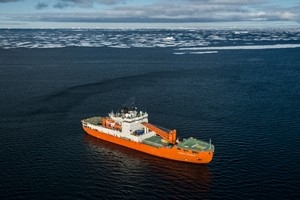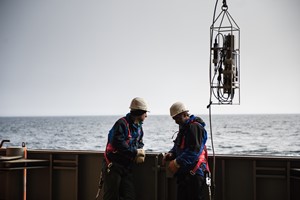Kara-Summer-2014, the largest summer Arctic expedition of Rosneft, finished fieldwork

Kara-Summer-2014, a research expedition organized by the Arctic Research and Design Center, supported by specialists of Arctic and Antarctic Research Institute has been successfully finished. It was the most large-scale summer expedition in the Northern seas since the fall of the Soviet Union. During 57 days from the board of a state-of-the-art Akademic Treshnikov scientific exploration vessel researchers of different institutions were conducting research of least explored areas in water basins of the Northern seas: the Kara Sea, the Laptev Sea, the East Siberian Sea and the Sea of Chukotsk. Also the works were conducted off the coast of Novaya Zemlya, Severnaya Zemlya and De Long Islands archipelagoes.
 The objectives of the expedition included surveys in the fields of meteorology, oceanology, litho-dynamics, geochemistry, volcanology, observation of ice and icebergs as well as biological and environmental surveys.
The objectives of the expedition included surveys in the fields of meteorology, oceanology, litho-dynamics, geochemistry, volcanology, observation of ice and icebergs as well as biological and environmental surveys.
In the course of the Kara-summer-2014 expedition Rosneft company installed a modern automatic station on the Uyedineniya Island and thus fully restored weather observation system in the Kara Sea. Moreover, within this large-scale program for restoring weather observation system everywhere in the Arctic Region the company experts have put into service two more meteorological stations of the same kind on the Preobrazheniya Island in the Laptev Sea and on the Zhokhov Island in the East Siberian Sea, which will allow providing the whole region with a full complex of weather condition observations. At the moment meteorological stations send latest information to the system of Federal Service for Hydrometeorology and Environmental Monitoring of Russia. Also maintenance prevention procedures of all the previously installed meteorological stations on the Novaya Zemlya archipelago have been carried out.
The special attention was paid to biological research, including monitoring of marine mammals and birds’ habitats. The research of polar bears was done. Zoologists were gathering data on distribution of polar bears in areas of interest. Also researchers took biopsy sample to evaluate the influence of environmental changes on polar bears. Adult female bears were tagged with collars equipped by satellite transmitters to track their migration paths.
 Apart from that a complex of oceanologic operations has been carried out. In the Kara Sea in the priority areas seasonal observations of streams, sea level fluctuations, swell conditions and sedimentation have been conducted using submerged autonomous buoy stations (SABS). For a one-year period 16 SABS were installed (10 in the Kara sea, 3 in the Laptev sea and 3 in the Chukotsk sea) to gather data about streams, swell conditions and sea level fluctuations, sedimentation, speed and direction of ice drift. Collected data will allow to make economically efficient and environmentally safe decisions on carrying out exploration drilling and development of production and transportation of hydrocarbons.
Apart from that a complex of oceanologic operations has been carried out. In the Kara Sea in the priority areas seasonal observations of streams, sea level fluctuations, swell conditions and sedimentation have been conducted using submerged autonomous buoy stations (SABS). For a one-year period 16 SABS were installed (10 in the Kara sea, 3 in the Laptev sea and 3 in the Chukotsk sea) to gather data about streams, swell conditions and sea level fluctuations, sedimentation, speed and direction of ice drift. Collected data will allow to make economically efficient and environmentally safe decisions on carrying out exploration drilling and development of production and transportation of hydrocarbons.
 Close attention in the Kara Sea and the Laptev Sea has been paid to icebergs and iceberg-producing glaciers. For this purpose there have been installed 62 ice buoys on icebergs to track their movement pattern, speed and drift direction. There has been carried out aerial photographic survey, which resulted in the construction of 3D models of above-water portion and evaluation of icebergs swarm. With the use of unique complexes, which software has been developed by Russian experts, there has been carried out over 700 km of radar-location and aerial photographic survey of glaciers of Novaya Zemlya and Severnaya Zemlya archipelagoes. This will allow to define their iceberg-producing potential. All the collected data will provide the basis for the development of management system over ice situation of shelf projects. In addition to it, there have been carried out advance geochemical survey in the waters of the Laptev Sea and the Chukotsk Sea. The goal of the survey was to localize areas prospective for hydrocarbons discovery. These were integrated works, which involved geophysical survey, sampling and analysis of soil sample and sea water. There have surveyed over 20 blocks in total.
Close attention in the Kara Sea and the Laptev Sea has been paid to icebergs and iceberg-producing glaciers. For this purpose there have been installed 62 ice buoys on icebergs to track their movement pattern, speed and drift direction. There has been carried out aerial photographic survey, which resulted in the construction of 3D models of above-water portion and evaluation of icebergs swarm. With the use of unique complexes, which software has been developed by Russian experts, there has been carried out over 700 km of radar-location and aerial photographic survey of glaciers of Novaya Zemlya and Severnaya Zemlya archipelagoes. This will allow to define their iceberg-producing potential. All the collected data will provide the basis for the development of management system over ice situation of shelf projects. In addition to it, there have been carried out advance geochemical survey in the waters of the Laptev Sea and the Chukotsk Sea. The goal of the survey was to localize areas prospective for hydrocarbons discovery. These were integrated works, which involved geophysical survey, sampling and analysis of soil sample and sea water. There have surveyed over 20 blocks in total.
Collected integrated data will be considered while planning business activities in the Arctic shelf, and for the development of technologies for safe hydrocarbon production in the Arctic. Follow-up field operations in the region are scheduled for March-May of 2015.
The expedition has been carried out in compliance with high proprietary standards of Rosneft in the region of environmental, industrial, and labor safety.
Rosneft Information Division
October 3, 2014